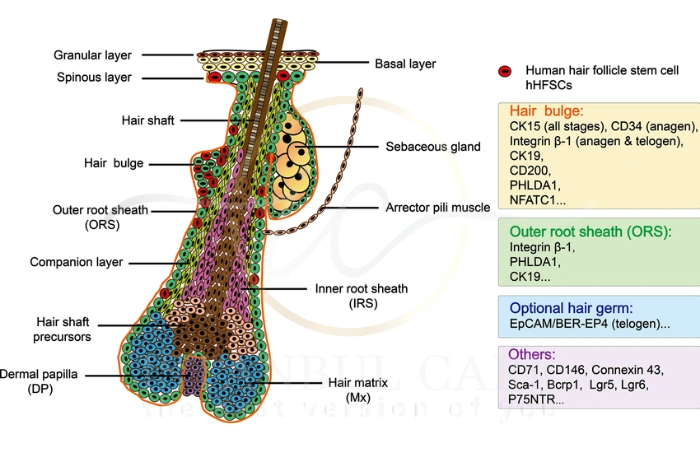Hair papilla cells represent one of the most crucial components in the complex mechanism of hair growth and regeneration. These specialized cells, located at the base of hair follicles, serve as the command center for initiating and maintaining healthy hair growth throughout our lives. Understanding how these remarkable cells function provides valuable insights into treating hair loss conditions and developing innovative therapeutic approaches.
The dermal papilla cells act as the master regulators of the hair growth cycle, orchestrating a sophisticated interplay of molecular signals that determine when hair grows, rests, and eventually sheds. These cells possess unique properties that make them essential for follicle induction and the continuous regeneration of hair throughout our lifetime.

How Hair Papilla Cells Stimulate Follicle Induction and New Growth
Hair papilla cells initiate follicle induction through a complex cascade of molecular signals that activate dormant stem cells in the hair follicle. These cells release specific growth factors and signaling molecules that create the optimal environment for new hair formation. The process begins when dermal papilla cells receive signals indicating the need for new hair growth.
During follicle induction, these specialized cells produce key signaling molecules including Wnt proteins, bone morphogenetic proteins (BMPs), and fibroblast growth factors (FGFs). These molecules work together to activate the hair follicle stem cells located in the bulge region of existing follicles. The Wnt/β-catenin signaling pathway plays a particularly important role in this process.
The dermal papilla cells also secrete extracellular matrix components that provide structural support for the developing hair follicle. This scaffolding ensures proper organization of the growing hair shaft and surrounding supporting cells. The induction process typically takes several days to weeks, depending on various factors including age, hormonal status, and overall health.
Research has shown that the size and activity level of the hair papilla directly correlate with the thickness and growth rate of the resulting hair. Larger, more active papillae produce thicker, faster-growing hairs, while smaller or less active papillae result in finer, slower-growing hair strands.
The Role of Dermal Papilla Cells in Hair Regeneration
Dermal papilla cells serve as the primary drivers of hair follicle regeneration, maintaining their regenerative capacity throughout life. These cells possess remarkable plasticity, allowing them to respond to various internal and external stimuli that influence hair growth patterns. Their regenerative function involves multiple phases of cellular activity and molecular signaling.
During the regenerative process, dermal papilla cells undergo significant changes in gene expression and cellular behavior. They increase production of growth-promoting factors while simultaneously reducing inhibitory signals that prevent hair growth. This delicate balance ensures optimal conditions for hair regrowth while preventing excessive or uncontrolled growth.
The cells also play a crucial role in recruiting and activating other cell types necessary for hair follicle regeneration. They attract immune cells, blood vessel cells, and various support cells that contribute to the overall regenerative process. This coordinated cellular response ensures that all necessary components are present for successful hair regeneration.
Stem cell activation by dermal papilla cells represents one of the most important aspects of hair regeneration. These cells produce specific signals that awaken dormant stem cells in the hair follicle bulge region, initiating the formation of new hair structures. The timing and intensity of these signals determine the success of the regenerative process.
Understanding the Hair Growth Cycle and Follicle Activation
The hair growth cycle consists of three distinct phases: anagen (growth), catagen (transition), and telogen (rest). Hair papilla cells regulate the transition between these phases through precise molecular timing mechanisms. Understanding this cycle is essential for developing effective treatments for hair loss conditions.
During the anagen phase, dermal papilla cells are highly active, producing numerous growth factors and maintaining close contact with the hair matrix cells. This phase can last several years for scalp hair, during which the hair shaft continuously grows. The hair growth cycle anagen phase is characterized by intense cellular proliferation and metabolic activity.
The catagen phase marks the beginning of follicle regression, where dermal papilla cells reduce their activity and begin preparing for the resting phase. This transition is carefully controlled to ensure proper cycling without permanent damage to the follicle structure. The cells maintain their essential characteristics during this phase to enable future regeneration.
Follicle activation occurs when dermal papilla cells receive appropriate signals to initiate a new growth cycle. These signals can come from various sources including hormones, growth factors, and environmental stimuli. The cells must be in the proper state to respond to these activation signals effectively.
Factors Secreted by Dermal Papilla Cells That Boost Regrowth
Dermal papilla cells secrete a diverse array of bioactive molecules that promote hair regrowth and maintain follicle health. These secreted factors include growth factors, cytokines, hormones, and extracellular matrix components. Each plays a specific role in the complex process of hair regeneration.
Vascular endothelial growth factor (VEGF) represents one of the most important growth factors secreted by hair papilla cells. VEGF promotes the formation of new blood vessels around the hair follicle, ensuring adequate nutrient and oxygen supply for growing hair. This vascularization is essential for supporting the high metabolic demands of rapidly dividing hair matrix cells.
Insulin-like growth factor-1 (IGF-1) is another crucial factor that stimulates hair matrix cell proliferation and extends the anagen phase of the hair growth cycle. Dermal papilla cells produce IGF-1 in response to various stimuli, including mechanical tension and hormonal signals. Higher IGF-1 levels correlate with increased hair growth rates and improved hair quality.
Hepatocyte growth factor (HGF) secreted by dermal papilla cells promotes stem cell activation and protects against hair follicle regression. This factor helps maintain the regenerative capacity of the follicle and prevents premature entry into the catagen phase. HGF also has anti-inflammatory properties that protect the follicle from damage.

How Dermal Papilla Cells Shape Hair Color and Type
Dermal papilla cells significantly influence hair characteristics including color, texture, and growth pattern through their interaction with melanocytes and hair matrix cells. These cells secrete specific signals that regulate melanin production and distribution within the growing hair shaft. The type and amount of melanin determine the final hair color.
The cells produce various signaling molecules that affect the differentiation of hair matrix cells into different hair shaft components. These signals determine whether the resulting hair will be straight, wavy, or curly, as well as its overall thickness and strength. Hair papilla cells essentially program the characteristics of each individual hair.
Genetic factors largely determine the baseline signaling patterns of dermal papilla cells, which explains why hair color and type are inherited traits. However, environmental factors and aging can modify these signaling patterns, leading to changes in hair characteristics over time. This explains why hair color often changes with age or in response to various stimuli.
The interaction between dermal papilla cells and melanocytes is particularly important for maintaining hair color. These cells produce factors that regulate melanocyte survival, proliferation, and melanin production. Disruption of these signals can lead to premature graying or changes in hair pigmentation patterns.
Exosomes and Conditioned Media from Dermal Papilla Cells for Regrowth
Recent research has revealed that dermal papilla cells release exosomes and other extracellular vesicles containing bioactive molecules that promote hair regrowth. These tiny vesicles carry proteins, lipids, and nucleic acids that can influence the behavior of other cells in the hair follicle. This discovery has opened new avenues for developing DP cell therapy approaches.
3D spheroid culture techniques have been developed to enhance the therapeutic potential of dermal papilla cells. When cultured in three-dimensional environments, these cells exhibit increased production of growth factors and improved regenerative capabilities. The spheroid culture method better mimics the natural environment of the hair follicle.
Conditioned media from cultured dermal papilla cells contains a concentrated mixture of growth factors and other bioactive molecules. This media has shown promising results in promoting hair follicle regeneration both in laboratory studies and early clinical trials. The approach offers a cell-free alternative to direct cell transplantation.
Hair follicle neogenesis research has demonstrated that exosomes from dermal papilla cells can induce the formation of entirely new hair follicles. This represents a significant advance in regenerative medicine and offers hope for treating severe hair loss conditions such as androgenetic alopecia. The exosomes appear to carry the essential signals needed for complete follicle formation.
Speak with our expert Hair Transplantation specialists

Speak with our expert Hair Transplantation specialists
We’re ready to answer your questions
FAQs for How Hair Papilla Cells Trigger Follicle Induction and Regrowth
Hair papilla cells serve as the control center for hair growth, regulating the hair growth cycle and producing essential growth factors that maintain healthy follicle function throughout life.
Dermal papilla cells secrete growth factors and signaling molecules that activate stem cells, promote follicle induction, and create optimal conditions for hair regrowth by orchestrating the entire regenerative process.
Yes, hair papilla cells and their secreted factors are being developed into innovative DP cell therapy treatments, including 3D spheroid culture techniques and exosome-based therapies for hair follicle regeneration.
Dermal papilla cells shape hair characteristics by secreting specific signals that determine hair color, texture, thickness, and growth patterns through their interactions with melanocytes and hair matrix cells during follicle development.

